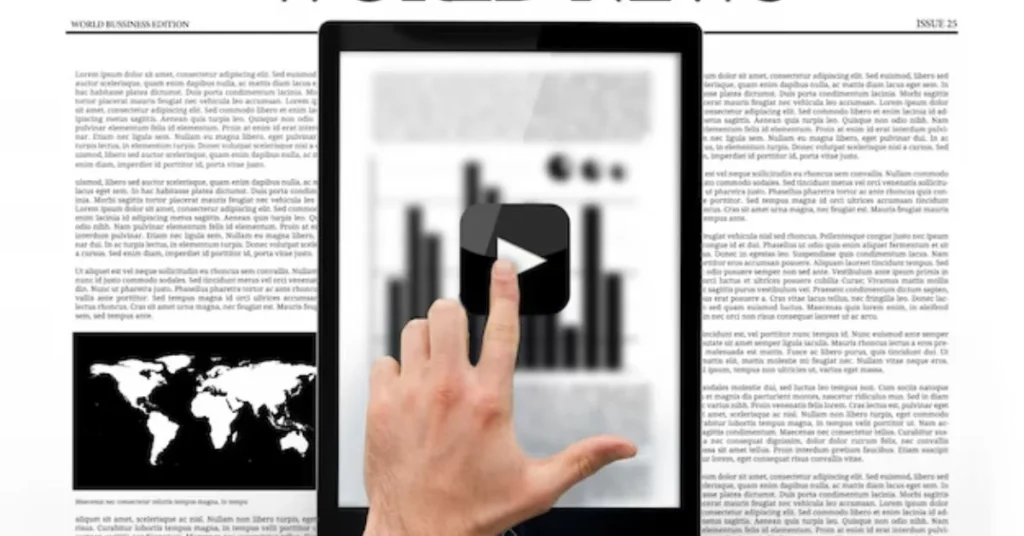The way people consume news has evolved dramatically with the rise of digital technology. The “smart newspaper” is a concept that embodies this evolution by blending traditional journalism’s credibility with advanced digital platforms’ accessibility, speed, and interactivity. At its core, the smart newspaper represents a digital transformation of news delivery, keeping readers informed, engaged, and empowered. In this article, we will explore the concept of a smart newspaper, the technology behind it, the benefits and challenges, and the future of news consumption in a digital-first world.
What is a Smart Newspaper?
A smart newspaper is a digital platform designed to deliver news in a dynamic, personalized, and interactive way. It leverages cutting-edge technologies, including artificial intelligence (AI), machine learning (ML), and data analytics, to curate content tailored to individual preferences. Unlike traditional newspapers, which deliver the same content to every reader, smart newspapers offer a customized news experience that considers each user’s interests, reading habits, and even their location.
Key Characteristics of a Smart Newspaper
- Personalization: Based on a reader’s history, interests, and behavior, smart newspapers provide tailored news stories.
- Real-Time Updates: Unlike print, which is static, newspapers constantly update news, providing real-time information.
- Interactivity: Readers can engage with the content, comment, share on social media, and access multimedia such as videos, graphics, and podcasts.
- Accessibility: Available on various devices, from desktops and tablets to smartphones, ensuring readers can stay updated wherever they are.
The concept of a smart newspaper aims to combine the credibility and depth of traditional journalism with the immediacy and flexibility of the digital era.
Technology Behind Smart Newspapers
The smart newspaper relies heavily on several key technologies to enhance its functionality, reach, and relevance:
- Artificial Intelligence and Machine Learning: AI and ML algorithms analyze reader preferences, consumption habits, and engagement patterns. This data enables the platform to predict the types of stories a reader is most likely interested in, creating a customized news feed that adapts to their tastes over time.
- Natural Language Processing (NLP): NLP helps smart newspapers analyze and summarize massive amounts of text, facilitating faster and more accurate information sorting. NLP also helps understand reader sentiment and adjust the tone or presentation of articles accordingly.
- Big Data and Analytics: Big data allows for real-time insights into user behavior. By tracking which articles readers click, share, and spend time on, it can continually refine their content and presentation, optimizing the reader experience.
- Push Notifications and Alerts: To keep users updated on the latest developments, newspapers use push notifications for breaking news, trends, or topics of interest, ensuring readers never miss crucial updates.
- Augmented Reality (AR) and Virtual Reality (VR): Some newspapers incorporate AR and VR to provide readers with an immersive experience. For example, readers could virtually attend events or explore infographics in 3D, enhancing their understanding and engagement.
Major Players in the Smart Newspaper Space
The success of smart newspapers has attracted numerous media companies and startups to invest in this technology. Among the most notable platforms is the Smart News app, a leading application in the newspaper industry. Founded in Japan, Smart News aggregates news from diverse sources, curating a balanced feed for readers. By incorporating local and global perspectives, it helps readers stay informed on topics of interest, which may vary significantly across regions and demographics.
The Smart News app download option has been popular worldwide, thanks to its unique features. It uses AI and ML to optimize user experience, creating a balanced perspective from diverse news sources, which is essential in a time of significant media fragmentation. With over 50 million downloads, it demonstrates the strong demand for smart newspapers in a digital age.

Benefits
Smart newspapers are redefining the user experience in ways that offer clear advantages for readers, publishers, and advertisers alike:
- Enhanced User Experience: With tailored news, real-time updates, and interactive content, readers get a seamless and engaging experience. News personalization allows readers to see more of what interests them and less of what doesn’t.
- Increased Engagement: The interactive nature of smart newspapers—complete with options to share, comment, and participate in discussions—keeps readers actively involved.
- Accessibility and Convenience: These are available across multiple devices, from smartphones and tablets to desktops, ensuring readers have access to news anytime, anywhere.
- Environmental Sustainability: Digital news reduces the need for paper, ink, and physical distribution, helping minimize the environmental impact traditionally associated with print newspapers.
- Revenue Opportunities: Through personalized ads, subscription models, and targeted campaigns, it can monetize more effectively, offering advertisers an opportunity to reach highly segmented audiences.
- Global and Local Reach: By aggregating content from around the world, smart newspapers allow readers to stay informed on both global issues and local events.
Challenges Facing
While the advantages of smart newspapers are numerous, they also face several challenges:
- Privacy Concerns: Smart newspapers require significant data collection to provide a customized experience, raising privacy concerns. Ensuring data security and maintaining user trust are critical issues for developers and publishers.
- Information Overload: With the abundance of content, readers can easily feel overwhelmed. Smart newspapers must strike a balance, providing relevant content without overwhelming readers.
- Bias and Filter Bubbles: While personalization is a benefit, it can also lead to echo chambers. If readers are only shown news that aligns with their preferences, they may miss out on diverse perspectives.
- Sustainability of Business Models: Although many smart newspapers operate on a freemium model, relying on ads or subscriptions can be challenging, particularly in a competitive media landscape. Long-term profitability remains a concern.
- Digital Divide: Smart newspapers require a device and internet access, which can be limiting for populations in low-income or rural areas.
Future of Smart Newspapers
The future of smart newspapers looks promising, with several trends expected to shape the landscape:
- Voice-Activated News Consumption: With the rise of smart speakers and voice assistants like Alexa and Google Assistant, smart newspapers may increasingly incorporate voice-activated features, allowing users to access news through verbal commands.
- Blockchain for Transparency and Trust: Blockchain technology may be employed to verify news sources and reduce the spread of misinformation, adding a layer of trust to smart newspapers.
- Increased AI Involvement: As AI technology continues to evolve, newspapers may offer even more refined personalization, translating to highly accurate content recommendations for readers.
- Immersive and Visual Journalism: With the expansion of AR and VR, it will offer more immersive experiences, enabling readers to virtually engage with news events, documentaries, and interactive visual content.
- Data-Driven Journalism: Leveraging big data and analytics, it will present more accurate and data-backed stories, allowing for enhanced investigative reporting.
The evolution of smart newspapers will likely continue, driven by advances in technology, shifts in reader expectations, and the ongoing transformation of the media landscape. As people increasingly turn to digital sources for news, the smart newspaper will play a crucial role in bridging the gap between reliable journalism and digital innovation.
Conclusion
The concept of the smart newspaper represents a significant leap forward in how we consume news, transforming it from a static experience into a dynamic, interactive, and personalized one. While challenges exist, such as privacy concerns and potential information overload, the benefits of smart newspapers in providing real-time updates, accessibility, and environmental sustainability are profound. As technology continues to advance, it will undoubtedly play a critical role in shaping the future of news consumption, offering readers a more immersive and engaging experience.
FAQs
1. What is a Smart Newspaper?
This is a digital news platform that uses AI and data analytics to deliver personalized, interactive, and real-time news updates, catering to each reader’s unique preferences and interests.
2. How is a Smart Newspaper different from traditional newspapers?
Unlike traditional newspapers that deliver the same content to everyone, this provide customized news based on the reader’s interests and allow real-time updates, interactive features, and accessibility on multiple devices.
3. Who is behind the Smart News app?
The Smart News app was developed in Japan and is now a leading smart newspaper platform worldwide, using AI-driven algorithms to curate balanced news content from diverse sources.
4. How can I download the Smart News app?
The Smart News app download is available on major app stores, including the Apple App Store and Google Play, providing easy access for iOS and Android users.
5. Is my data safe with Smart News platforms?
It prioritize data security and privacy, using encryption and secure protocols. However, users should review privacy policies to understand how their data is used for personalization.
6. Will smart newspapers replace print newspapers?
While smart newspapers are becoming more popular due to their convenience and personalization, print newspapers continue to hold value for many readers. This complement print by offering a digital, dynamic news experience.









